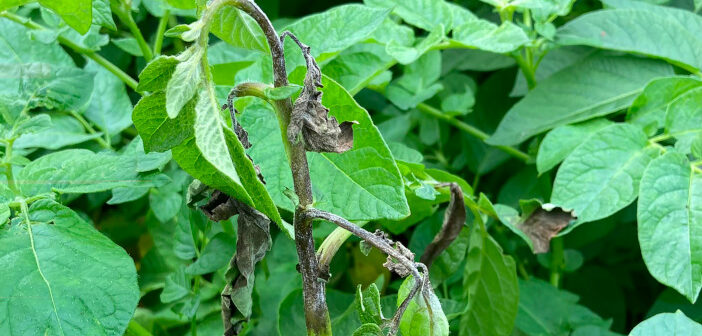With the withdrawal of mancozeb coming into effect later this year, UK growers will need to develop alternative protection strategies to control potato blight in 2025 and beyond.
Mancozeb is the mainstay multi-site fungicide active ingredient for the control of potato blight. Its approval is, however, confirmed to expire on 31st May 2024. As a result, the final date for the sale and supply of all products containing mancozeb will be 31st November 2024, with the final storage, disposal and use-up period ending on 31st November 2025.
Potato growers will therefore need to modify their blight protection programmes accordingly. And, although alternative active ingredients are available, the rules and regulations surrounding their use and application intervals aren’t entirely straightforward and are further complicated by confirmed cases of resistance to some key actives on the continent.
“For example, instead of being able to apply three consecutive applications of CAA (carboxylic acid amide) fungicides, the latest FRAC (Fungicide Resistance Action Committee) guidance is that these should now be limited to a maximum of two consecutive applications,” explains ProCam agronomist, Harry James.
Mr James considers this sensible based on the loss of efficacy of this group of fungicides on the continent, with crop protection manufacturers such as Syngenta going a step further by advocating the use of mandipropamid in alternation with fungicides with a different mode of action.”
Resistance to oxathapiprolin (Zorvec) has also been confirmed in some parts of northern continental Europe including the Netherlands, Belgium and Germany, with the post-Zorvec application interval being reduced from 10 days to 7 as a result. It must also be used in alternation with a non-CAA chemistry.
“This will make it more labour intensive and time consuming to keep crops clean,” Mr James describes, “especially as this key active no longer provides a curative effect. Instead, it can only be relied on to deliver preventative activity which means sprays will need to be applied on time every time in order for crops to remain protected.
He advises that to avoid confusion growers should seek the advice of their agronomist. He also suggests growers need to realise that although fungicide resistance hasn’t yet been confirmed in UK crops, the risk remains high and is further escalated by the shortfall in British seed potatoes which means there’s a risk of resistant strains being introduced by imported seed stock.
“The high incidence of foliar and tuber blight in continental seed crops means there’s a very real risk of resistance affecting British crops,” Mr James continues. “For that reason, anti-resistance strategies – alternating modes of action and limiting the exposure of any single active – must be followed from the outset.
“Keeping a close eye on resistance updates throughout the season will be essential, as will taking professional advice to devise a suitable spray programme, not least because the ever-changing legislative position and evolving resistance situation will make keeping abreast of the latest rules that much more complex.
“But, with careful planning, growers and their agronomists should still be able to achieve good levels of blight control and stay ahead of the threat of resistance. It must be stressed, however, that the key to reliable control will be to adapt programmes according to weather conditions and to use forecasting tools to determine when the threat of blight is at its highest. Cultural controls, such as selecting varieties with better natural blight resistance, and taking extra care to remove volunteer potatoes from dumps and other crops in the rotation should also be factored into the equation.
“Nothing, however, will beat getting into the field and putting boots on the ground to assess the crop, the severity of disease pressure and if a blight infection has occurred,” Mr James concludes.




